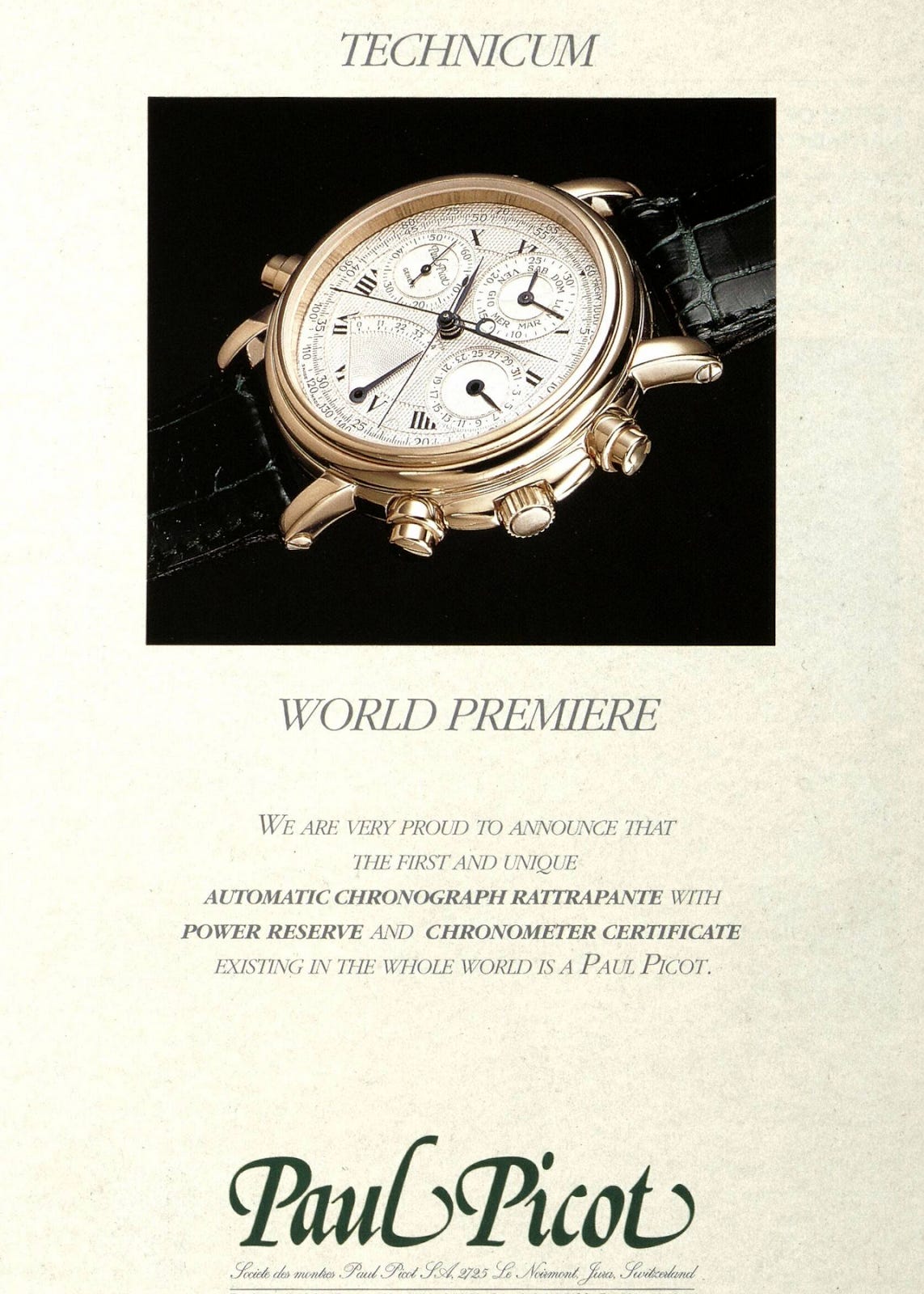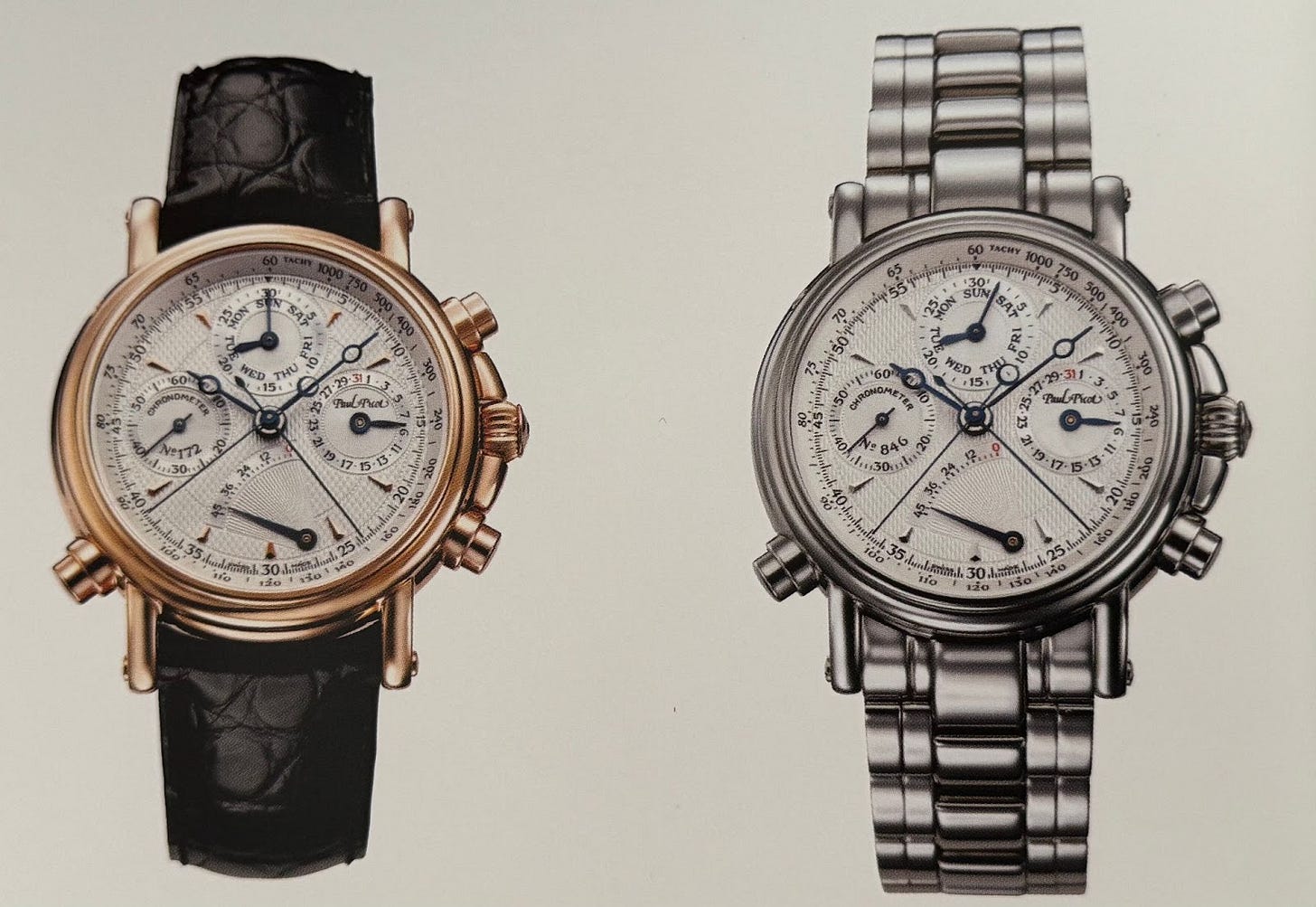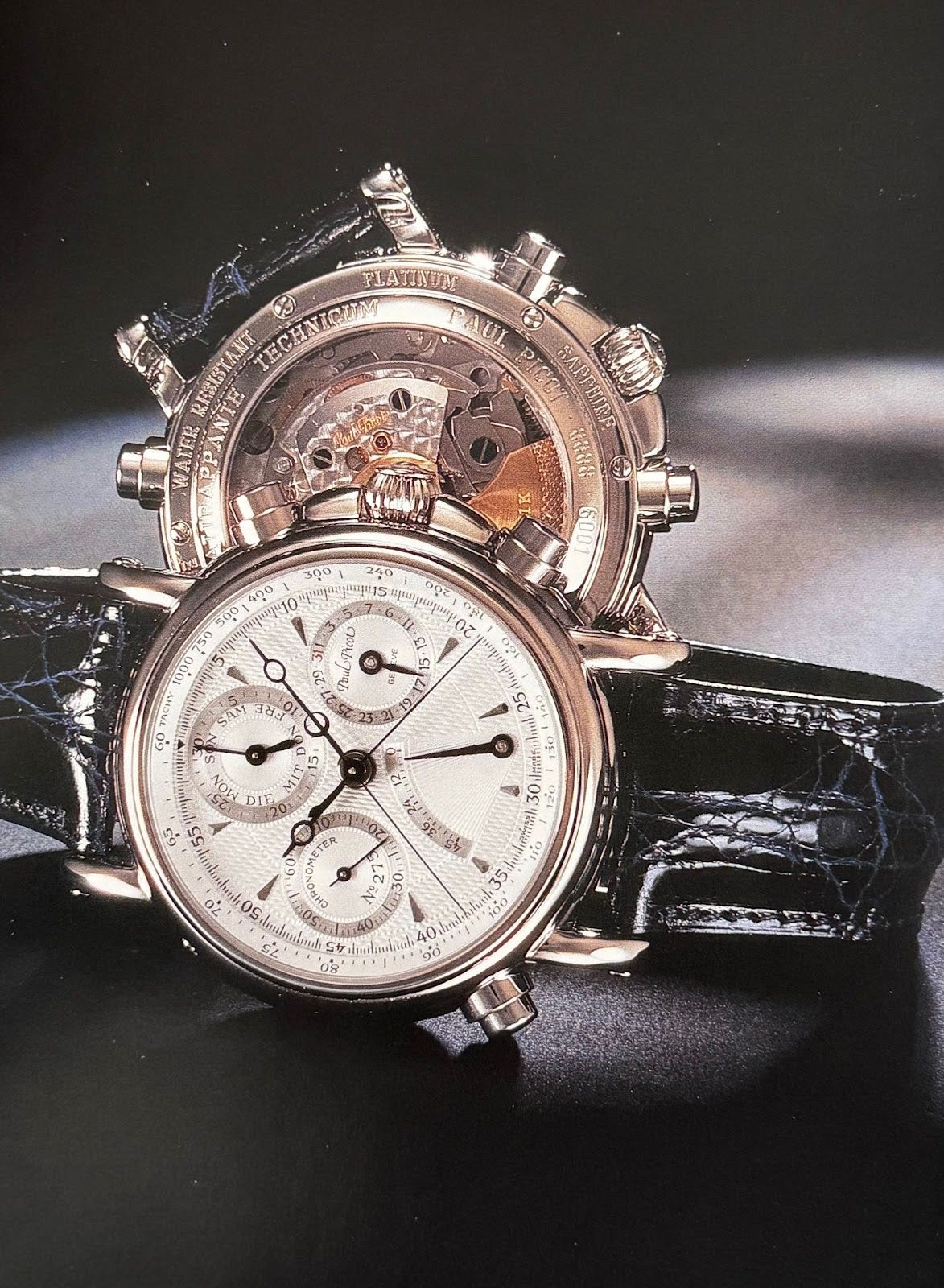In the mid-1980s, Switzerland was still shaking off the aftershocks of the quartz crisis. Whole valleys of watchmaking had fallen quiet, their machines sold for scrap, their traditions seemingly consigned to history.
And yet, in corners of this bruised landscape, certain figures emerged who insisted that mechanical watchmaking was not only alive but had a future—provided it could be clothed in cultural meaning. Paul Picot, a brand founded in 1976 at the height of quartz dominance, was one such contrarian. Its Technicum line, introduced in 1991, was more than a mere watch collection: it was a manifesto, an assertion that horology could fuse technical virtuosity with cultural resonance.
The Technicum was not born in a vacuum. It drew from a moment when mechanical watches were being repackaged as artifacts of continuity and craft, as symbols of a Switzerland trying to reconcile modernity with tradition. And in its most audacious form—the Calibre PP-8888 automatic chronograph with split-seconds, power reserve, and day-date display—the Technicum claimed uniqueness. A machine so proudly excessive, it became its own declaration of survival.
The Cultural Landscape
The late 1980s were suffused with paradox. On one hand, Europe seemed to be accelerating into a future of global finance, deregulation, and electronics. On the other, there was a mounting hunger for anchors—symbols of permanence in a world increasingly ruled by plastic and pixels.
The Technicum belonged to this cultural soil. Its name alone—half-Latin, half-scientific—suggested a hybrid identity: not a nostalgic throwback, but neither a surrender to Japanese microchips. Instead, it offered a distinctly Swiss compromise, one that promised precision as science yet dressed it in artisanal romance.
Music, art, and literature of the period reflected similar tensions. Neo-expressionist canvases returned to gesture and paint after decades of conceptual detachment. In music, analog synthesizers coexisted uneasily with digital samplers, just as collectors rediscovered vinyl in an age of compact discs. Watches, too, became emblems of resistance against the smooth, weightless future: heavy, mechanical, undeniably physical.
The Technicum positioned itself not merely as a tool for telling time, but as a cultural artifact that resonated with this climate of skepticism and yearning.
Strategy and Survival
Behind the cultural gestures lay a hard strategy. Paul Picot was a relatively small brand compared to giants like Omega or Rolex. It could not outspend them in marketing or distribution. Instead, it leaned into an insider strategy: appealing to collectors and connoisseurs who valued authenticity over scale.
The decision to launch the Technicum was both audacious and calculated. Its core proposition lay in celebrating complications—chronographs, perpetual calendars, split-seconds mechanisms—at a moment when such things were still novelties to most consumers. The quartz crisis had reduced the mechanical watch to an eccentric luxury; Paul Picot wagered that this eccentricity could be reframed as exclusivity.
The original Technicum’s PP-8888 calibre was no ordinary engine. COSC certified, with a 21k gold rotor, 47 hours power reserve, based on a Valjoux 7750 with 73 custom-fabricated parts, it paraded its craftsmanship at a time when quartz could have sufficed. Production was deliberately limited—never scaled into the tens of thousands, but instead nurtured in the hundreds. Most tellingly, a 20th-anniversary edition released in 2011 was capped at 100 pieces, a quantification that spoke more loudly than any marketing slogan. Rarity was not an afterthought; it was the brand’s central strategy.
Geography also played its part. Situated in Le Noirmont, Paul Picot tapped into the surviving skills of the Jura region. While global supply chains were being rationalized, the Technicum embodied a different logic—that of proximity, heritage, and continuity. It was not simply a Swiss watch, but a product of a specific valley and its stubborn insistence on survival.
Narrative Integration
The brilliance of the Technicum lies in how seamlessly it connected cultural values with strategic necessity. The cultural appetite for permanence, for objects that resisted disposability, aligned perfectly with the brand’s inability to scale. What might have been seen as a limitation—low production, artisanal methods—became recoded as virtue.
Collectors did not merely buy a Technicum for its mechanics; they bought into a narrative. It was the story of resistance: against quartz, against globalization, against the weightless promises of the digital age. Each watch whispered a reminder that time could still be measured by gears and springs, not by the blinking of liquid crystals.
And Paul Picot offered variety to amplify this whisper: steel and gold two-tone cases, solid 18k rattrapantes, and later, in the re-imagined Technicum 1872 of 2011, either pink gold or steel hand-wound chronographs powered by the Lemania 1872. Each shift in material and mechanism was not simply a design choice, but a coded message—an insistence that small-scale horology could still stand for endurance and refinement.
Critical Turning Points
Several moments proved decisive. The first was the late 1980s revival of mechanical complications, driven in part by independent watchmakers like Franck Muller and Daniel Roth. Their daring creations validated the Technicum’s strategic bet, creating a cultural space in which Paul Picot could plausibly participate.
Another turning point was the rise of the collector market in the early 1990s. Auction houses began to elevate vintage mechanical watches to new price levels, legitimizing the mechanical renaissance. For Paul Picot, this provided not just validation but also urgency: the Technicum was no longer eccentric, but aligned with a broader movement of rediscovery.
Yet not all consequences were intentional. By leaning heavily on complications, Paul Picot tied its identity to a trend it could not entirely control. As larger brands with deeper pockets entered the complication game, the niche that the Technicum helped pioneer became increasingly crowded. And by the 2000s, production appears to have wound down entirely. The Technicum slipped quietly from the main catalog—re-emerging briefly in the 2010s as a nostalgic homage, before being discontinued altogether.
The Importance of the Original Technicum Today
The passing decades have only deepened the Technicum’s paradox. For the wider market it remains obscure. For collectors, that obscurity sharpens its appeal.
The watch sits in the liminal category of connoisseur’s pieces—objects whose value lies not in universal recognition but in the quiet nods exchanged among those who know.
Auction listings are rare, values modest compared to marquee names. Yet scarcity—real scarcity, not the fabricated churn of modern “limited editions”—remains its shield.
For the investor-collector, the Technicum is both risk and opportunity. Risk, because Paul Picot lacks the cultural shadow of Rolex or Patek. Opportunity, because history often belatedly rewards the overlooked.
The PP-8888 models with their gold rotors, the two-tone rattrapantes, the full gold executions—these appear increasingly overbuilt for their time, technical statements ahead of the market. Today, that excess reads as prescience.
In short: to own a Technicum is to hold a fragment of the moment when Swiss watchmaking rehearsed its own resurrection. Whether values climb or not is secondary; what matters is the story it confers on its custodian.
Collector’s Guide: Paul Picot Technicum
Production
Introduced in 1991 with the PP-8888 calibre.
Total produced in the low hundreds; 2011 anniversary edition capped at 100 pieces.
Production wound down by the 2000s; discontinued except for a brief 2011 reissue.
Movement
PP-8888: Valojoux 7750 modified with 21k gold rotor, 73 proprietary custom parts.
2011 reissue (Technicum 1872) used Lemania 1872 hand-wound movement.
Variants
Steel rattrapantes with tachymeter.
Two-tone steel and 18k gold executions.
Full 18k gold models with guilloché dials.
2011 reissue available in pink gold or steel, white or anthracite dials.
Collector Market
Rare at auction; values modest compared to marquee brands.
Most sought-after: early PP-8888 models with gold rotors and the 1993 limited run.
Value lies in narrative and scarcity, not mass recognition.
Legacy and Memory
The legacy of the Technicum is, like much of Swiss watchmaking history, layered and ambiguous. On one level, it succeeded in its immediate task: it helped reassert the dignity of mechanical horology at a time when dignity was in short supply. On another, its longer-term impact was less visible. Unlike Rolex or Patek Philippe, Paul Picot did not become a household name. Its watches remained within the circle of cognoscenti, more often discussed in hushed tones at collectors’ dinners than in glossy advertisements.
Historians of horology debate how to situate the Technicum. Some see it as a footnote, an earnest but ultimately marginal contribution to the mechanical revival. Others argue that precisely because it lacked the resources of the giants, its example is all the more telling: it shows how even modest brands could harness cultural and strategic forces to carve out survival in a hostile environment.
Cultural memory has been selective. The Technicum is rarely invoked in mainstream watch discourse, yet among insiders it carries a certain aura: a reminder that the survival of Swiss watchmaking was not the work of titans alone, but of a scattered network of believers, each stubborn enough to gamble against the odds. The 100-piece anniversary edition, the two-tone rattrapantes, the Lemania-driven 2011 revival—these fragments now circulate as artifacts of a time when survival was not guaranteed, and when obscurity itself could become a kind of legacy.
In contemporary relevance, the Technicum feels oddly prescient. As today’s industry grapples with questions of sustainability, authenticity, and slow luxury, the Paul Picot experiment reads like a first draft of ideas that would only later gain traction. Limited production, artisanal methods, cultural storytelling—these are now buzzwords across the luxury sector. In the early 1990s, they were survival tactics disguised as poetry.
Closing Reflection
The Technicum occupies a curious place: neither forgotten nor fully remembered, both peripheral and essential. Its greatest complication was not the split-seconds hand or power reserve.
It was survival itself.
👉 If you enjoyed this essay, consider subscribing to WatchDossier. One new longform piece every 2–3 weeks: cultural, skeptical, and unapologetically long on watches.






